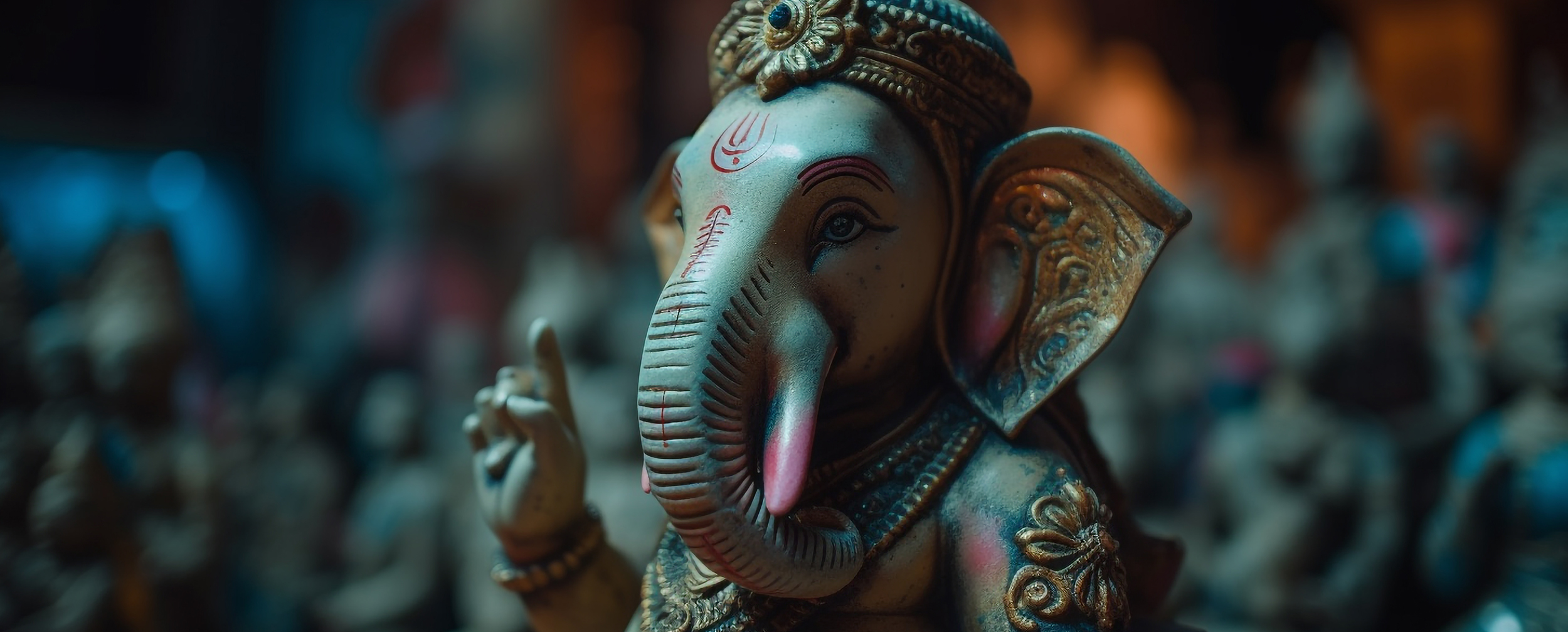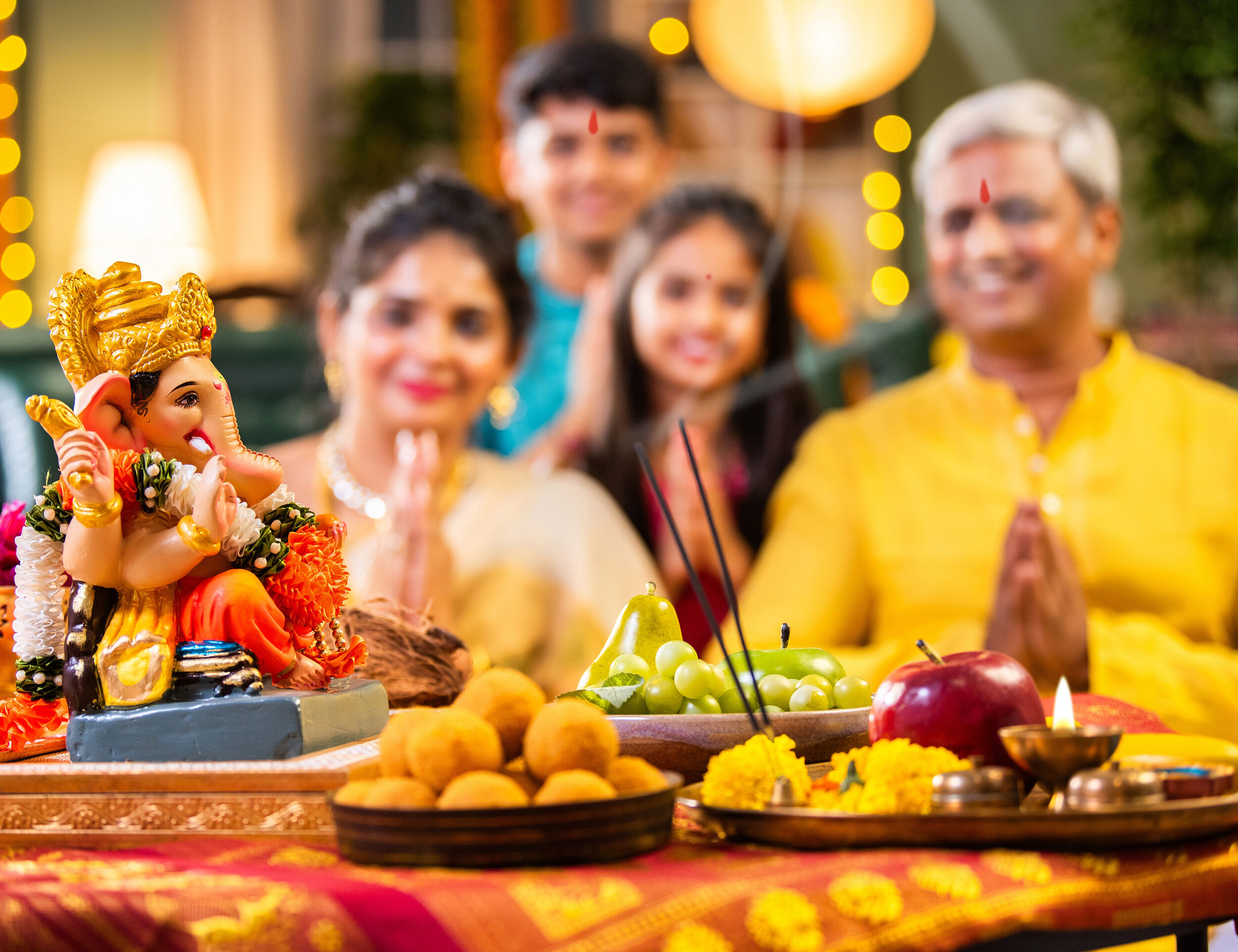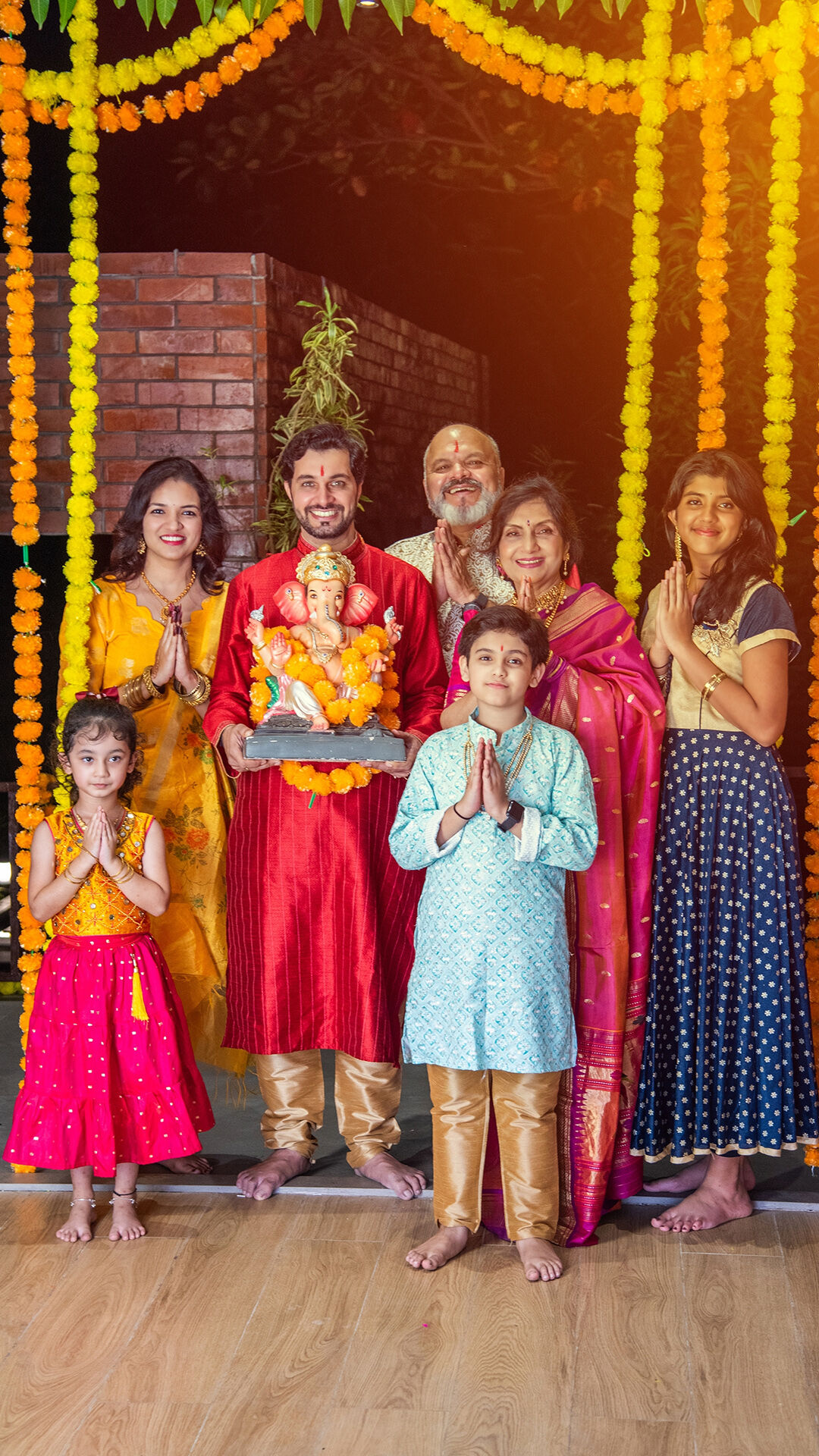STORIES BY MANYAVAR & MOHEY

Lifestyle
The Story Behind Ganesh Chaturthi: Why We Celebrate Lord Ganesha’s Birth
Date 19 August 2025 Reading time: 7-10 mins
Festivals in India come with their own flavours, stories, and traditions. Among the many celebrations that dot our cultural calendar, Ganesh Chaturthi stands tall with its deep roots and joyous spirit.
Ganesh Chaturthi history traces back thousands of years, with the celebration finding mentions in texts from the Kadamba Dynasty (4th century CE). This blog dives into the fascinating story behind why we celebrate Ganesh Chaturthi – from the mythological birth of Ganesha to the festival's historical significance in India's freedom struggle.
Overview of Ganesh Chaturthi
As the calendar turns to the Hindi month of Bhadrapada, homes across India prepare for a special guest. Clay artisans put finishing touches on Ganpati idols, while families plan elaborate welcome ceremonies. But what is Ganesh Chaturthi? It's a 10-day Hindu festival marking the birth of Lord Ganesha, falling in August-September on Shukla Paksha Chaturthi of Bhadrapada month.
From small household celebrations to massive community events, Ganesh Chaturthi history shows how this festival has evolved from a private religious observance to a grand public celebration.
Importance of Lord Ganesha in Hindu Culture
The importance of Ganesh Chaturthi stems from Ganesha's position as the remover of obstacles (Vighnaharta) and the god of new beginnings. This is why no auspicious work, project, or ceremony begins without first invoking his blessings. From weddings to housewarmings and business launches to academic pursuits, Lord Ganesha's approval is sought first.
His wisdom is symbolised by his large head, while his small mouth represents the need to listen more and speak less. The broken tusk he holds teaches sacrifice, and his large ears remind us to listen carefully to others. Even his mouse vehicle carries meaning, showing how one must control desires that nibble away at our spiritual progress.
The Mythological Birth of Lord Ganesha
Storytelling sessions during Ganesh Chaturthi often begin with the fascinating tale of how the elephant-headed god came to be. Children gather around grandparents, eyes wide with wonder, as the mythological story of Ganesh Chaturthi unfolds.
Creation by Goddess Parvati
The story begins with Goddess Parvati, who lived with Lord Shiva on Mount Kailash. According to Ganesh Chaturthi history, Parvati often found herself alone as Shiva would meditate for years or go on long journeys. One day, while preparing for a bath, she realised she had no attendant to guard her door.
Using her divine powers, Parvati gathered sandalwood paste from her body and mixed it with turmeric. With this fragrant mixture, she created a handsome boy and breathed life into him. This was the birth of Ganesha – created not from physical birth but from the creative power of the divine mother.
Why we celebrate Ganesh Chaturthi connects directly to this creation story – it honours not just Ganesha himself but also celebrates the divine feminine creative energy represented by Goddess Parvati.
The Role of Lord Shiva in Ganesha's Story
The mythological story of Ganesh Chaturthi takes a dramatic turn when Lord Shiva returns home. Unaware of Parvati's creation, Shiva approaches their dwelling, only to find an unfamiliar boy blocking his path.
"Who are you?" demanded Shiva. "And why do you prevent me from entering my own home?"
"I am Parvati's son," replied the boy proudly. "And I have strict instructions not to let anyone in while she bathes."
Lord Shiva, known for his fiery temperament, was both surprised and angered that a young boy would prevent him from entering his own abode. When Ganesha steadfastly refused to let him pass without Parvati's permission, a fierce battle ensued.
The Ganesh Chaturthi history tells us that though Ganesha fought bravely, he was eventually overpowered by Shiva, who, in a moment of rage, severed the boy's head with his trishul (trident).
The Elephant Head: Symbolism and Significance
When Parvati emerged and saw her creation headless, her grief turned to fury. She assumed her fierce form of Goddess Kali and threatened to destroy the entire universe. To pacify her and rectify his action, Shiva promised to revive Ganesha.
He ordered his followers, the ganas, to bring the head of the first creature they encountered facing north. They returned with an elephant's head, which Shiva attached to the boy's body, breathing new life into him.
The Legend of Ganesha's Birth
While the most popular mythological story of Ganesh Chaturthi involves his creation from sandalwood paste, Hindu mythology offers several alternative accounts of Ganesha's birth. Each variation adds rich layers to Ganesh Chaturthi history and explains different aspects of his worship.
Parvati's Desire for a Protector
Long before creating Ganesha, Ganesh Chaturthi history tells us that Parvati yearned for a child to call her own. Her husband Shiva's ascetic nature meant he was often lost in meditation for decades or centuries at a time. Parvati longed for companionship during these periods and this maternal desire forms an important part of why Ganesh Chaturthi is celebrated for 10 days – it honours the bond between mother and child.
The Encounter with Lord Shiva
The fateful meeting between the newly created Ganesha and his future father forms the dramatic centre of the importance of Ganesh Chaturthi. Ganesha, instructed to guard his mother's privacy, took his duty extremely seriously.
According to Ganesh Chaturthi history, Shiva sent his ganas (attendants) to remove the boy, but Ganesha defeated them all single-handedly.
Even Brahma, Vishnu, and other gods could not overcome Ganesha's dedication to his mother's command. This part of the story teaches the importance of duty and keeping one's word – values central to why Ganesh Chaturthi is celebrated with such devotion.
Ganesha's Beheading and Resurrection
When Parvati discovered what had happened, her grief was boundless. According to Ganesh Chaturthi history, she was so distraught that she threatened to destroy creation itself. To appease her, Shiva promised to revive her son and grant him divine status.
To honour his resurrection, Shiva declared that Ganesha would be worshipped first before beginning any auspicious work – explaining a key aspect of why we celebrate Ganesh Chaturthi at the start of important undertakings.
Significance of Celebrating Ganesh Chaturthi
Beyond the fascinating mythology, why is Ganesh Chaturthi celebrated with such enthusiasm across India? The festival carries multiple layers of significance – religious, cultural, and historical.
Worship of the Remover of Obstacles
The primary reason why we celebrate Ganesh Chaturthi relates to Ganesha's role as Vighnaharta – the remover of obstacles. By worshipping him, devotees seek his blessings to overcome challenges in their lives.
How to celebrate Ganesh Chaturthi traditionally involves a 16-step ritual called Shodashopachara puja, which includes:
- Invocation (Avahana) – welcoming the deity
- Offering a seat (Asana)
- Washing the feet (Padya)
- Offering water (Arghya)
- Giving a bath (Snana)
The precise rituals vary by region, but the underlying devotion remains constant. This aspect of Ganesh Chaturthi history highlights how the festival serves as a spiritual anchor for millions.
Seeking Blessings for New Beginnings
Another reason why Ganesh Chaturthi is celebrated relates to new ventures. As the patron of beginnings, Ganesha's blessings are sought when starting new projects, businesses, academic years, or life stages.
The festival often coincides with the beginning of the harvest season in many parts of India, making it a natural time to seek divine favour for prosperity. Understanding what is Ganesh Chaturthi in this agricultural context reveals how the festival blended spiritual and practical aspects of life.
Community Bonding and Festive Spirit
The social dimension answers another aspect of why is Ganesh Chaturthi celebrated so widely. The festival brings communities together, transcending caste, class, and regional differences. How to celebrate Ganesh Chaturthi in modern times often involves community pandals, cultural programmes, sharing of prasad, and joint processions during visarjan (immersion ceremony).
Cultural Impact of Ganesh Chaturthi
This community aspect of Ganesh Chaturthi celebrations gained particular prominence during India's freedom struggle, when Lokmanya Tilak transformed the festival into a platform for national unity against British rule in 1893 – an important chapter in Ganesh Chaturthi history that gave the celebration its public character.
Regional Variations in Celebration
How to celebrate Ganesh Chaturthi varies fascinatingly across India's diverse cultural landscape. Each region adds its unique flavours to the festivities:
- In Maharashtra: The grandest celebrations occur in Mumbai and Pune with massive public idols, dhol-tasha pathaks (drum troupes), and elaborate processions.
- In Andhra Pradesh and Telangana: Clay idols are adorned with turmeric and vermilion, with special pujas performed for 21 days.
- In Tamil Nadu: The festival coincides with Vinayaka Chaturthi, featuring kozhukattai (rice dumplings similar to modaks).
- In Gujarat: Families observe a day-long fast followed by evening aarti and prasad distribution.
Modern Festivities and Traditions
Contemporary Ganesh Chaturthi history shows evolution alongside preservation. Today's celebrations blend age-old rituals with modern concerns:
- Eco-friendly idols made from natural clay instead of plaster of Paris
- Digital aartis and online puja services for global devotees
- Social media campaigns sharing why Ganesh Chaturthi is celebrated for 10 days
- Community service initiatives during the festival period
Celebrating Faith, Devotion, and New Beginnings
The festival teaches valuable life lessons through its rituals:
- Idol installation teaches the importance of inviting positive energies
- Daily aarti emphasises gratitude and devotion
- The 10-day duration shows the value of sustained spiritual practice
- Immersion ceremony reminds us about impermanence
Embracing the Spirit of Lord Ganesha
The fascinating Ganesh Chaturthi history we've explored reveals why this festival continues to captivate hearts across India and beyond. From the dramatic tale of Ganesha's unusual birth to his elevation as the first deity to be worshipped, the story carries timeless wisdom.
For those looking to honour rituals while expressing personal style during these celebrations, Manyavar offers festival attire that respects cultural heritage while meeting contemporary tastes. Celebrate this Ganesh Chaturthi in outfits that reflect both heritage and individuality!







